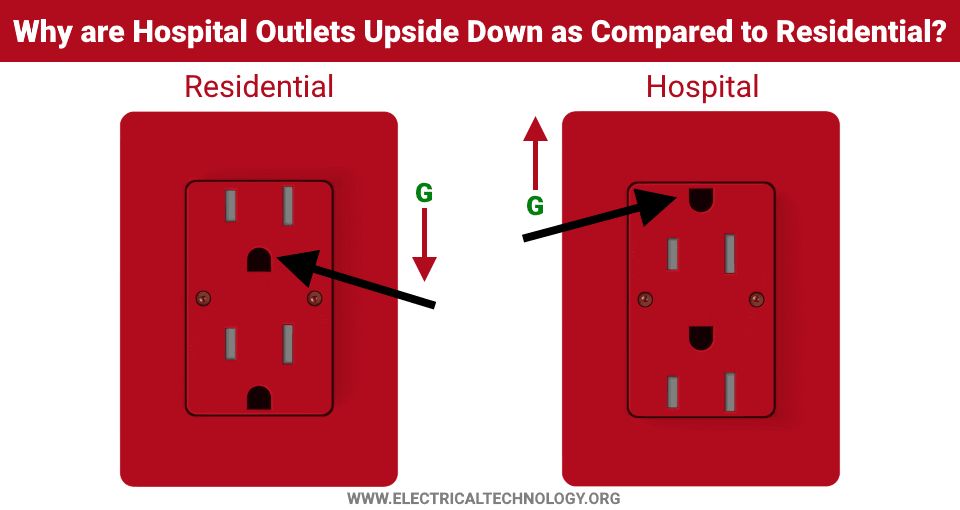Electrical outlets are something we use every day without much thought. However, you may have noticed that sometimes outlets are installed upside down, with the ground hole on top instead of the bottom. Why is this? There are actually a few reasons why upside down outlets exist.
Page Contents
Historical Reasons
Believe it or not, upside down outlets used to be the proper way to install them. Up until the 1960s, the National Electrical Code (NEC) specified that outlets should be installed with the ground hole on top. There were a couple reasons for this:
- Safety – With the ground hole on top, if something metal accidentally fell onto the outlet, it would hit the ground first rather than the hot and neutral slots. This protects against potential shocks and sparks.
- Convenience – Lamp plugs were often designed with the neutral prong at the bottom and the hot prong at the top. This allowed the lamp to hang down properly. With the ground on top, the outlet matched the design of these plugs.
However, in the 1960s and 70s, grounding practices evolved. Appliance plugs began to standardize with the ground prong on the bottom. The NEC code changed to reflect this, requiring new installations to have outlets with the ground hole on the bottom.
Grandfathered Outlets
When the NEC code changed to upside down outlets no longer being proper, existing outlets were grandfathered in. Any outlets already installed with the ground on top did not have to be changed. Even today, these grandfathered outlets are still permitted under the NEC as long as they were compliant when they were installed.
This is why you may encounter upside down outlets in older homes and buildings. If they were installed prior to the 1960s code change, they were likely installed upside down per the standards at that time. As long as they are still in good condition, there is no need to replace them.
Specific Use Cases
While upside down outlets are generally seen as the “old way”, there are a few cases where they are still used today:
- Behind Furniture: If an outlet is positioned behind a piece of furniture, such as a bed or dresser, it may be installed upside down to make it easier to plug things in. The cord will hang down naturally instead of being pressed against the wall.
- Specific Equipment: Some heavy equipment and appliances are designed with the neutral and hot prongs flipped on the plug. Upside down outlets better match the design of these appliance plugs.
- Reduced Tampering: In public spaces, upside down outlets are sometimes used to deter people from plugging in their personal electronics. The upside down configuration signals it is not a public outlet for general use.
Child Safety
One of the most common reasons provided for installing outlets upside down today is child safety. The theory is that young children may try to poke something into an outlet and will be less likely to do so if the ground hole is on top instead of the energized slots. There is truth to this, as the ground hole will not electrocute them.
However, most electricians do not recommend relying on this. Children’s safety around outlets should depend more on tamper-resistant receptacles and covers, keeping outlets obstructed, and supervision. An upside down outlet should not replace proper childproofing.
Does Orientation Affect Performance?
Some people claim that flipping outlets upside down improves performance or is better for electrical flow. This is not true. The orientation of the outlet does not impact performance at all. Upside down and rightside up outlets have the same electrical specs and work exactly the same electrically. The only potential advantages are for convenience and safety as outlined above.
Conclusion
While upside down outlets used to be the proper way to install them, today they are seen as an older, outdated method. However, you may still encounter them for historical reasons or in specific use cases. Just remember that the orientation does not affect the outlet’s electrical performance at all. As long as an upside down outlet is reasonable safe and functions fine, there is no need to replace it with modern standards.
| Time Period | Proper Orientation | Reasoning |
|---|---|---|
| Prior to 1960s | Upside down | Safety, convenience with lamp plug design |
| 1960s-1970s | Transition to rightside up | Ground prong began being placed on bottom of plugs |
| After 1970s | Rightside up | Match new NEC code and appliance plug design |
| Situation | Use Upside Down? |
|---|---|
| Behind furniture | Yes, for cord convenience |
| Heavy equipment with reversed plug | Yes, to match appliance |
| Public spaces | Yes, to deter public use |
| Improve child safety | No, use tamper-resistant outlets instead |
| Improve performance | No, orientation does not affect performance |
